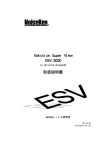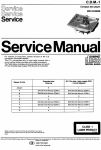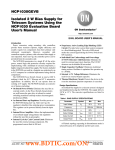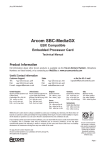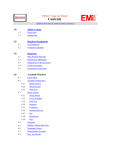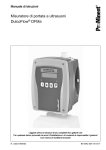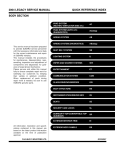Download Anritsu_MS2601B
Transcript
SPECTRUM ANALYZERS SPECTRUM ANALYZER MS2601B/K 9 kHz to 2.2 GHz High-Speed Measurement of Various Devices GPIB The MS2601B/K is a wide-band spectrum analyzer which covers the video to VHF/UHF bands. The synthesized local oscillator and automatic calibration, which uses a highly accurate signal source, enable accurate frequency and level measurement. In addition, the MS2601B/K has new and original functions such as the zone marker and scroll function, that shorten measurement time. Furthermore, plug-in memory cards (PMCs) for storing measurement conditions and waveform data offer excellent operability. Advanced functions • High-level built-in automatic calibration The MS2601B/K automatically calibrates itself using the calibration signal from the built-in signal source each time the CAL key is pressed. The calibration data is processed at high speed by a 16-bit microprocessor and the compensation value is added to the displayed measured value. The reliability of measurements has been greatly improved and the measurement error has been reduced to about one-third of conventional models, resulting in a general level measurement accuracy of 1 dB. Furthermore, when the working temperature changes drastically, an accurate measurement can be made just by pressing the CAL key. • Digital technology supports high-accuracy measurement Digital technology, including a synthesized local signal, has been used to greatly improve the level measurement accuracy. Also, the signal peak-level frequency can be measured with 1 Hz resolution even at a 2.2 GHz full sweep. Furthermore, in addition to having a QP detector, three resolution bandwidths, and time constants based on CISPR standards, the antenna calibration coefficients are automatically calculated to facilitate the best EMI measurement. • IC cards for spectrum analyzers The age of spectrum analyzers operated by IC cards has now arrived. The MS2601B/K uses IC memory cards called PMCs to store measurement conditions and waveform data. For example, once the test procedures are stored in the PMCs, measurements can be made under the same conditions at any time. You can keep your hard-earned measurement conditions as your personal know-how. Also, if these PMCs are used with the Personal Test Automation (PTA) program memory, automatic measurement can be packaged in a card. 164 • PTA widens realm of automatic measurements The PTA function is a high-level language for measurement and a computer integrated in a spectrum analyzer. Programs for measurements, operation, and display, etc. can be input to the MS2601B/K via the keyboard or a personal computer. Thus, the spectrum analyzer can be configured quickly into automatic test equipment. PTA supports complicated measurements as well as preparation of final test results. The MS2601B/K can be used as a frequency counter, power meter, and real-time computer for measurement operations, or as ATE combining these functions, as well as a spectrum analyzer. Also, various support software is available to enable connection to factory automation LANs (local area networks). Main applications • Measuring transmission quality such as spurious emissions from radio communication equipment • Measuring electromagnetic interference (EMI) • Testing high-frequency parts such as RF converters and tuners • Measuring various devices such as filters and ICs Measurement examples Correct frequency count even at 2.2 GHz-span sweep The zone markers can be aligned with the desired signal even while observing the entire signal at full span sweep. A 2.2 GHz signal frequency can be measured at 1 Hz resolution (see below). www.anritsu.com For product ordering information, see pages 4-7. SPECTRUM ANALYZERS Overall level accuracy of ±1 dB Reproducible high-accuracy level measurements are ensured through internal signal calibration, initiated simply by pressing the CAL key on the MS2601B/K (see below). In addition, there is little cumulative LOG linearity error so that measurements of transmission characteristics are carried out with the same high accuracy achieved by network analyzers. Frequency axis scroll function Sometimes the signal on the left or right of the displayed portion must be examined in detail during a slow sweep (see below). Just press the scroll key to move the display two divisions left or right on the screen. This permits areas beyond the edge of the screen to be displayed without waiting for a new sweep to display the entire waveform. 2 Zone marker easily locates signals. This zone marker function (patent pending) has been developed to reduce the measurement time. Simply enter zone markers around the signal frequency and the peak value within that zone will be measured with 0.03 dB resolution and displayed, even if the exact frequency varies. This eliminates troublesome marker adjustment to the signal peak each time you want to read the frequency and level (see below). The frequencyadjustment capability for an oscillator under test has been increased remarkably, and the frequency display remains visible during adjustment. EMI measurement In addition to providing a QP detector and three resolution bandwidths and time constants based on CISPR standards, antenna calibration coefficients are automatically calculated to facilitate easy EMI measurement. Application software MX4102B Transmitter Test System Software The MX4102B software can be used for efficient testing of mobile transmitter equipment that uses PTA (optional). This software can be used to measure frequency, high-order harmonic spurious components (second to fifth order harmonics), occupied bandwidths, and the adjacent channel power. Specifications Model Frequency Measurement frequency range MS2601B MS2601K 9 kHz to 2.2 GHz Frequency setting 0 to 2210 MHz (stop frequency: ≥1 kHz) Display resolution 20 Hz Setting mode CENTER/SPAN, START/SPAN, START/STOP Set frequency span (stop freq.– start freq.) to 2 digit value (10 to 98) Frequency display accuracy ±(100 Hz + freq. span x 2% + display freq. x reference freq. accuracy) For CENTER/SPAN or START/SPAN mode, after auto-calibration, provided that freq. span is ≥10 kHz and sweep time is ≤100 s Frequency span Setting range: 1 kHz to 2200 MHz for horizontal 10 divisions, 2-digit (10 to 98) variable, and 0 Hz (fixed tuning) 1 kHz to 2000 MHz, 1-2-5 sequence at step keys Readout accuracy: ±2% (sweep time ≤100 s) Resolution Resolution bandwidth: 30 Hz to 1 MHz (3 dB bandwidth), variable in 1-3 sequence, can be selected manually or automatically coupled to frequency span Resolution bandwidth accuracy: ±20% Selectivity: ≤15 : 1 (ratio of 60 dB and 3 dB bandwidth) Stability Residual FM: ≤20 Hz p-p/0.1 s (frequency span; ≤500 kHz) Drift: ≤300 Hz/min (frequency span; ≤500 kHz, sweep time; ≤100 s, after 1-hour warm-up at constant ambient temperature) Sideband noise ≤–80 dBc (at 100 Hz resolution bandwidth, 1 Hz video bandwidth, 10 kHz from signal) Continued on next page For product ordering information, see pages 4-7. www.anritsu.com 165 SPECTRUM ANALYZERS Model MS2601B Frequency Reference oscillator NORMAL Markers Delta COUNT Measurement range Display Frequency response (20° to 30°C) –130 to +20 dBm –124 to +20 dBm Divisions: 8 divisions on vertical axis when top line is reference level and scale is 10 dB/div 10 divisions on vertical axis for other scales LOG (referred to reference level): 0 to –70 dB (10 dB/div), 0 to –50 dB (5 dB/div), 0 to –20 dB (2 dB/div), 0 to –10 dB (1 dB/div) LIN: 10%/div of reference level (calibrated in voltage, unit: V) Linearity LOG: ±0.2 dB/0 to –10 dB, ±0.3 dB/0 to –20 dB, ±0.5 dB/0 to –50 dB (resolution bandwidth of 100 Hz to 1 MHz), ±1 dB/0 to –70 dB (resolution bandwidth of 100 Hz to 100 kHz), after automatic calibration LIN: ±3% of reference level (fullscale) ±0.5 dB (100 kHz to 1.5 GHz), ±1.5 dB (9 kHz to 2.2 ±0.5 dB (100 kHz to 2.0 GHz), ±1.5 dB (9 kHz to 2.2 GHz), input ATT at 20 dB GHz), input ATT at 20 dB LOG: +20 to –100 dBm (setting resolution 0.1 dB), 2750 mV to 2.70 µV LIN: 2750 mV to 87.1 µV Accuracy ±0.3 dB (0 to –50 dBm), ±0.75 dB (+20 to –70 dBm) after automatic calibration at frequency of 50 MHz and frequency span ≤2 MHz (resolution bandwidth, video bandwidth, sweep time, and input ATT settings at AUTO) Average noise level Amplitude Function: Displays received signal frequency at marker Resolution: 1 Hz, 10 Hz, 100 Hz selectable Accuracy: Display frequency x reference frequency accuracy ±(2 counts or 20 Hz, whichever is greater) LOG: +20 to –100 dBm (setting resolution 0.1 dB), 2240 mV to 2.20 µV LIN: 2240 mV to 70.8 µV Resolution bandwidth switching deviation ±0.3 dB (after automatic calibration) ≤–120 dBm (frequency 1 MHz to 2 GHz) with 0 dB input ATT, 300 Hz resolution bandwidth, 1 Hz video bandwidth ≤–114 dBm (frequency 1 MHz to 2 GHz) with 0 dB input ATT, 300 Hz resolution bandwidth, 1 Hz video bandwidth 2nd and 3rd harmonic distortion ≤–75 dB (frequency 5 to 800 MHz) when 0 dB input ATT and –30 dBm input level Residual response ≤–100 dBm (frequency ≥500 kHz) when 0 dB input ATT and 50 Ω input termination ≤–95 dBm (frequency ≥500 kHz) when 0 dB input ATT and 75 Ω input termination Marker Normal: Displays the level at settable marker Delta: Displays the difference in levels between the settable marker and the reference marker Noise measurement: Both the power of noise per 1 Hz bandwidth (dBm/Hz, dBc/Hz), and the adjacent channel power (dBm/ch, dBc/ch) can be measured. Video bandwidth 1 Hz, 10 Hz, 100 Hz, 1 kHz, 10 kHz, 100 kHz, OFF (selected manually or automatically coupled to resolution bandwidth) Level unit dBm, dBµV, dBmV, dBµV (emf), dBµV/m LOG/LIN switching loss ≤±1 dB (after calibration at room temperature) Quasi-peak detection 6 dB bandwidth: 200 Hz, 9 kHz 120 kHz ±30% (at room temperature) Time constants for quasi-peak detection Charge-time constant: 45 ms (for 6 dB bandwidth at 200 Hz), or 1 ms (for 6 dB bandwidth at 9 kHz and 120 kHz) Discharge-time constant: 500 ms (for 6 dB bandwidth at 200 Hz), 160 ms (for 6 dB bandwidth at 9 kHz), or 550 ms (for 6 dB bandwidth at 120 kHz) Display time constant: 160 ms (for 6 dB bandwidth at 200 Hz and 9 kHz), or 100 ms (for 6 dB bandwidth at 120 kHz) Display: LOG scale; 5 dB/div (10 div) Linearity: ±1 dB (for –40 to 0 dB carrier wave signal, at room temperature) Field strength measurement Antenna correction coefficients for correct display and measurement of field strengths (dBµV/m) can be selected for certain antennas. Antenna correction coefficients have been stored in memory for the following antennas: MP534A/651A, MP635A/666A, MP414B The user may define and store antenna coefficients (for one antenna) via the GPIB interface. Any set of user-defined antenna correction can be selected for correct display and measurement of field strengths (dBµm). The user may define and store antenna coefficients (for one antenna) via the GPIB interface. Impedance 50 Ω, VSWR ≤1.5 (input ATT; ≥10 dB, frequency; ≥30 kHz), N-type connector 75 Ω, VSWR ≤1.5 (input ATT; ≥10 dB, frequency; 30 kHz to 2 GHz), NC-type connector Maximum input level +25 dBm (input ATT; ≥10 dB), DC: ±50 V +25 dBm (input ATT; ≥10 dB), DC: ±100 V RF input Sweep Function: Displays frequency at tunable marker Display accuracy: Same as center frequency display accuracy Function: Displays frequency difference between reference marker and tunable marker Display accuracy: Same as frequency span display accuracy Setting range Reference level Dynamic range MS2601K Frequency: 10 MHz Stability Starting characteristic: Within ±5 x 10–8(after 20-minute warm-up, referred to frequency after 1-hour warm-up) Aging rate: Within ±2 x 10–8/day, ≤1 x 10–7/year (referred to frequency after 24-hour warm-up) Temperature characteristic: Within ±5 x 10–8(referred to frequency at 25°C) External reference input Frequency: 10 MHz, Level: 2 to 5 Vp-p Input ATT Attenuation: 0 to 50 dB, in 10 dB steps (selected manually or automatically coupled to reference level) Switching accuracy: ±1 dB (100 kHz to 1.5 GHz), ±2.0 dB (9 kHz to 2.2 GHz) Sweep time Setting range: 50 ms to 1000 s variable in 1-1.5-2-3-5-7 sequence. Range can be selected manually or automatically according to frequency span, resolution bandwidth, and video bandwidth. It can also be set from 50 ms to 1000 s (according to the most significant 2-digits) via the GPIB interface. Accuracy: ≤±15% (for 50 ms to 100 s range) or ≤±30% (for 100 to 1000 s range) at room temperature Trigger FREE RUN, LINE, VIDEO, SINGLE, EXT TRIGGER Sweep range Normal: Sweeps entire range, Zone marker width setting range: 1 to 501 points (odd numbers) Zone sweep: Sweeps range between zone markers, Zone marker width setting range: 25 to 501 points (odd numbers) Continued on next page 166 www.anritsu.com For product ordering information, see pages 4-7. SPECTRUM ANALYZERS CRT display Model MS2601B MS2601K CRT Six-inch electromagnetic deflection type (green display color) Display items Graticule (grid), waveform data, setting conditions, menu, title Waveform data display method The display screen uses digital storage, 501 points of data for horizontal-axis data, and 2 display channels (A and B): Either channel can be selected for NORMAL, AVERAGE, MAX-HOLD, or MIN-HOLD waveforms, but only channel A can be used for the CUMULATIVE and OVERWRITE mode of displaying stored data. Channels A and B can be displayed simultaneously. Detection method PEAK, SAMPLE and DIP can be selected. Direct plotting Screen data can be hard-copied to a plotter or printer via the GPIB interface (RS-232C interface for option 02) Plotter compatibility: HP-GL or GP-GL compatible Printers: EPSON’s VP-870 (or compatible models), or Hewlett-Packard’s 2225 2 ALL CAL: Calibrates all LEVEL CAL 1, LEVEL CAL 2 and FREQ CAL functions LEVEL CAL 1: Calibrates total gain deflection and log linearity LEVEL CAL 2: Calibrates resolution bandwidth, reference level, and LOG/LIN switching deflection FREQ CAL: Calibrates local frequency errors, and the center frequency of the resolution bandwidth QP CAL: Calibrates the on/off switching error apparent in quasi-peak detection Internal memory: Save/recall 6 setting conditions PMC: Save/recall 12 (32 KB) or 48 (128 KB) setting conditions and measurement data Automatic calibration Function memory External control GPIB (IEEE488, IEC625-1, 24 pins): All functions except power switch, CRT intensity, PMC control, GPIB address, AM/FM modulator (option 07) and direct plotting controlled. Interface: SH1, AH1, T6, L4, SR1, RL1, PP0, DC1, DT1, C0 Auxiliary signal input and output IF output Frequency: 3.6 MHz, Output level: 0 dBm ±3 dB (at the reference line on the CRT), Connector: BNC-type 50 MHz output Frequency: 50 MHz, Output level: –2 dBm ±3 dB, Connector: BNC-type X, Y and Z outputs X-axis output: From 0 V (left edge) to 10 ±1 V (right edge), terminated at ≥100 kΩ, BNC-connector Y-axis output*1: From 0 V (lower edge) to 1 ±0.3 V (upper edge), terminated at ≥100 kΩ, BNC-connector Z-axis output: TTL level (level is low while sweep is in progress), BNC-connector Video output Composite: 1 Vp-p ±0.3 V, BNC-connector Separate: 8 pins, DIN-connector Probe power supply: +5 V ±10%, +15 V ±10%, –15 V ±10% (each 110 mA max.), 4-pole connector External trigger input: TTL level (rising edge active), BNC-connector External reference signal input: Use 10 MHz, 2 to 5 Vp-p reference input signal (input impedance: ≥2 kΩ), BNC-connector Power *2Vac Dimensions and mass 284 (W) x 177 (H) x 451 (D) mm, ≤18.5 kg (without options) Operating temperature range 0° to 50°C EMC*3 EN55011: 1991, Group 1, Class A EN50082-1: 1992 +10 –15 %, 50/60 Hz, ≤145 VA (DC operation with MZ144A Battery Pack or MZ145B DC/DC Converter) Y-axis outputs are not automatically calibrated, their amplitude specifications are not guaranteed. *1:2: Since one nominal line voltage between 100 and 240 V when ordering. Maximum operational voltage is 250 V. *3: Specify * Electromagnetic Compatibility Options • Option 01: PTA (with external keyboard), Option 04: PTA (without keyboard) Display Number of display characters: 57 characters x 25 lines (small), 48 characters x 25 lines (medium), 41 characters x 25 lines (large) Displayable characters: Upper-case and lower-case characters, numerals, special symbols, and cursor Character font: 7 x 11 dot matrix (small), 9 x 13 dot matrix (medium ), 10 x 13 dot matrix (large) Graphic: 4 screens, 400 x 575 dots Keyboard Character keys: Upper-case and lower-case characters, numerals, and special symbols Editing keys: DEL, INS, < , > , , Command keys: RUN, STEP, RETURN, RES PTL Program area: 200 KB Commands: Basic commands (18 types) and GPIB statements (2 types) Functions: Arithmetic functions, logical functions, and system functions System subroutines: Display subroutines and GPIB subroutines Variables: Numeric, string, and system variable Interfaces: GPIB and I/O ports, RS-232C and I/O port (Option 02) > PTA-S201 < PTA model • Option 02: RS-232C interface Communication mode Start-stop, full-duplex Baud rate 300, 600, 1200, 2400, 4800 bps Data bit 7, 8 Parity bit Odd, even, none Start bit 1 bit Stop bit 1, 1.5, 2 bits Control items All items except power on/off, CRT intensity, PMC management, AM/FM modulator (Option 02), direct plotting and RS-232C parameters Connector DB-25P or equivalent For product ordering information, see pages 4-7. www.anritsu.com 167 SPECTRUM ANALYZERS • Option 05: Following changes to specifications Option MS2601B option 05 Frequency measurement range MS2601K option 05 100 Hz to 2.2 GHz Frequency response ±0.5 dB (100 Hz to 2.0 GHz), input ATT at 20 dB, temperature range 20° to 30°C ±0.5 dB (100 Hz to 1.5 GHz), input ATT at 20 dB, temperature range 20° to 30°C Dynamic range Average noise level: Following added to standard model ≤–80 dBm (1 to 10 kHz) ≤–100 dBm (10 to 100 kHz) ≤–110 dBm (100 kHz to 1 MHz) At 0 dB input ATT, 30 Hz RBW, 1 Hz VBW Average noise level: Following added to standard model ≤–74 dBm (1 to 10 kHz) ≤–94 dBm (10 to 100 kHz) ≤–104 dBm (100 kHz to 1 MHz) At 0 dB input ATT, 30 Hz RBW, 1 Hz VBW Impedance: 50 Ω, VSWR ≤1.5 At ≥10 dB input ATT, ≥100 Hz frequency Impedance: 75 Ω, VSWR ≤1.5 At ≥10 dB input ATT, 100 Hz to 2 GHz frequency Amplitude RF input Maximum input level: +25 dBm (≥10 dB input ATT), DC ±0 V Input ATT switching accuracy ±1.0 dB (1 kHz to 1.5 GHz), ±2.0 dB (1.5 to 2.0 GHz) Ordering information Please specify model/order number, name, and quantity when ordering. Model/Order No. MS2601B MS2601K J0025A J0104 J0017 F0012 P0005 J0308 J0121 J0017 F0012 P0005 MS2601-01 MS2601-02 MS2601-04 MS2601-05 MS2601-07 MS2601-08 MS2601-09 MC3305A MC3306A MX4102B P0007 P0008 MA8601A MA8601J MH680A1 MA8610A MH648A MZ144A MZ145B MP534A MP651A 168 Name Model/Order No. Main frame Spectrum Analyzer (RF input: 50 Ω) Spectrum Analyzer (RF input: 75 Ω) MS2601B standard accessories Coaxial cord, N-P-5W • 5D-2W • N-P-5W, 1 m: 1 Coaxial cord, UG-88U • RG55/U • N-P-55U, 1 m: 1 Power cord, 2.5 m: 1 Fuse, 3.15 A: 2 Memory card, 32 KB: 1 MS2601B/K operation manual: 1 MS2601B/K service manual: 1 pc pc pc pcs pc copy copy MS2601K standard accessories Coaxial cord, BNC-P • 3C-2WS • NCP-3W, 1 m: 1 Coaxial cord, NCP-3W • 3C-2WS • NCP-3W, 1 m: 1 Power cord, 2.5 m: 1 Fuse, 3.15 A: 2 Memory card, 32 KB: 1 MS2601B/K operation manual: 1 MS2601B/K service manual: 1 pc pc pc pcs pc copy copy Options PTA (with external JIS type PTA keyboard) RS232C interface (used in exchange for GPIB interface) PTA (without PTA keyboard) Frequency range: 100 Hz to 2.2 GHz (MS2601B: with MA8601A, MS2601K: with MA8601J) AM/FM Modulator (cannot be installed simultaneously with Option 09) Protector (cannot be installed simultaneously with B0025 protective front cover) Tilt Handle (cannot be installed simultaneously with Option 07) Optional instruments and parts JIS Type PTA Keyboard ASCII Type PTA Keyboard Transmitter Test System Software Memory card, 128 KB Memory card, 256 KB DC Block Adapter (50 Ω) DC Block Adapter (75 Ω) Tracking Generator Pre-amplifier (9 kHz to 2.2 GHz) Pre-amplifier Battery Pack DC/DC Converter Dipole Antenna Dipole Antenna BBA9106 6502 MP635A MP666A MB18B MB9A MB19A MP414B MP415B MZ126A MP612A MP613A MP640A MP654A J0063 J0395 MP526A MP526B MP526C MP526D MP526G B0215 B0213 B0214 B0225 B0226 B0025 B0029 B0038 B0231 MP520A MP520B MP520C MP520D MP614A MB009 MA2601B MA2601C KT-10 P6201 MA8611A www.anritsu.com Name Biconical antenna (30 to 300 MHz, 50 Ω) Loop antenna (10 kHz to 30 MHz, 50 Ω) Log-periodic Antenna Log-periodic Antenna Pole (for MP666A) Tripod Tripod (with a pole, for MP635A/666A) Loop Antenna (9 kHz to 30 MHz, 3 bands) Rod Antenna (9 kHz to 30 MHz, 3 bands) Band Selector (for MP414B/MP415B) RF Fuse Holder (DC to 1000 MHz, 50 Ω) Fuse Element (5 pcs/set, for MP612A) Branch Coupler Fixed attenuator for high power measurement (10 W, DC to 12.4 GHz, 30 dB) Fixed attenuator for high power measurement (30 W, DC to 9 GHz, 30 dB) High-Pass Filter (for 60 MHz band) High-Pass Filter (for 150 MHz band) High-Pass Filter (for 250 MHz band) High-Pass Filter (for 400 MHz band) High-Pass Filter (for 27 MHz band) Rack mount Carrying case (with casters) Carrying case (without casters) Carrying bag (with casters) Carrying bag (without casters) Protective front cover (cannot be installed simultaneously with option 08) Stacking feet Front handle kit CRT hood CM Directional Coupler CM Directional Coupler CM Directional Coupler CM Directional Coupler 50/75 Ω Impedance Transformer 50/75 Ω Impedance Transformer EMI Probe EMI Probe EMI clamp FET probe (Tektronix product) EMI Probe Kit (case, MA2601B, MA2601C, MA8610A, cable) Case for MA8611A For product ordering information, see pages 4-7.







